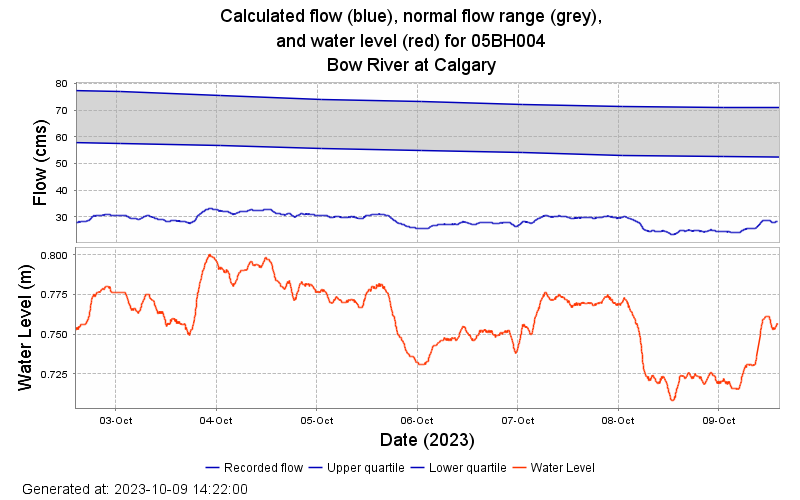Outdoor watering restrictions are still in effect in Calgary and those rules may become normal in the future.

The Bow River through Calgary is at far below normal levels, according to data from Alberta’s river basin dashboard.
A provincial graph shows that the flow rate of the Bow River in Calgary is around 28 cubic metres per second. Normal levels for this time of the year should be between 50 to 70 cubic metres per second.
“The Bow River is at a historical low since 1911,” said Nicole Newton, manager of natural environment and adaptation for the City of Calgary.
This is the first time that the City of Calgary has enacted outdoor water restrictions as a result of drought. They went into effect in mid August and are still in effect now. They will likely be lifted later this fall according to Newton, but that will not signal that we are out of a drought.
“We are in a hydrological drought and we look to Calgarians to start thinking of ways they can use water wisely, perhaps indoors as we move through the winter,” Newton said. “Water is a precious resource that we have to start thinking longer-term about,”
In response to the drought, the City of Calgary’s Drought Resilience Plan was approved at a community development committee meeting on Oct. 2.
The plan says drought is a top climate hazard in Calgary. One of the strategies being contemplated is a permanent outdoor watering schedule that goes into effect automatically in the spring.
Newton said a number of neighboring communities around Calgary have watering schedules that are in effect for six months of the year and they typically come off around the end of October.
Okotoks has an outdoor watering schedule to help maintain water supply levels and balance the water reserves available to meet the community’s needs.
Stage One in Okotoks comes into effect on May 1 each year, and this year the town moved to Stage Two earlier than it had in the past.
“Watering schedules are something that the city of Calgary is looking at. We’d like to take a look at and make sure we understand the impact of the policy decision before proceeding with it,” Newton said.
The strategy will still need final approval at a Calgary city council meeting.
Supporters of the strategy say it’s about behavior change, much like with recycling.
“twenty years ago that wasn’t part of the behavior of communities, residents and businesses. Now look at how far we’ve come,” said Pat Letizia who was speaking at the committee meeting.
For now, the city is asking Calgarians to continue to conserve water.
According to the city’s website, even-numbered addresses can use sprinklers, soaker hoses or in-ground systems for a maximum of two hours on Wednesdays or Saturdays between 4 and 7 a.m., 9 and 11 a.m. or 7 and 10 p.m.
Odd-numbered addresses can do so on Thursdays or Sundays for two hours during the same time periods.
There is no restriction on watering cans, hoses with shut-off sprays or watering wands that turn off when not in use.
“If we don’t get the rain and we don’t get the snowpack that we typically rely on as our major source of water, we will be looking at water restrictions going into next summer, possibly earlier in the summer,” Newton said.
She said Calgarians saved just over 1.1 billion litres of water because of the outdoor watering restrictions, which is equivalent to about 450 Olympic-size swimming pools.
“We have to think long-term behaviourally about how we manage our lawns and what we think is aesthetically pleasing. Having the greenest lawn on the block probably isn’t always needed,” Newton said.




Comments